Adam Larson
Caustic Logic/The Frustrating Fraud
Last Updated 5/26/07
In their effort to cast doubt on the official story of the Pentagon attack, Loose Change explained that a 757 is driven by “two Pratt and Whitney Engines made of steel and titanium alloy which are nine feet in diameter, twelve feet long, and weigh six tons each.” Considering government claims that the plane entirely disintegrated in the fire (an explanation I’m certain they’re exaggerating), “it is scientifically impossible that twelve tons of steel and titanium was vaporized by kerosene." We’ve seen no intact nine-foot engines, and they couldn't have burned away, so a logical conclusion would be they never existed. “The two engines should have been found relatively intact. Instead, there was a single turbojet engine approximately three feet in diameter found inside the building.” I’m not sure where they got this from, but the only source coming to mind (Desmoulins, whose evidence we'll see below, and his wasn't intact either). But one small engine would mean we’re looking at a missile, not a plane.
Jim Hoffman's 9-11 Review noted of the Loose Change take “perhaps ‘engines should have been found relatively intact’ if the Pentagon were made out of bamboo. Since when has an engine survived a 500-mph impact with a masonry building relatively intact?” [1] Indeed, the engines are not so solid as Dylan made them sound. First off, citing the engines as being nine feet across and solid titanium is deceptive – what we see that’s so big is the engine with its outer housing. The outer shell is strong enough to withstand winds but not concrete walls, against which it would be shredded. I’m not sure what they’re made of but I’m guessing well-formed composite plastic materials in multiple layers with reinforcing fibers and whatnot. They could also be metal, or some mix, but essentially it's just a sturdy aerodynamic shell. The hard titanium alloy stuff is inside the actual engine, which is six feet in diameter at its widest point – the front fan - and considerably narrower otherwise. The variously sized and carefully arranged internal parts – gears, center shaft, burners, housings - would mostly remain intact after the crash and fire, but not necessarily neatly assembled any more.
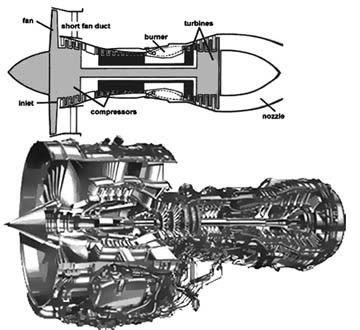
The engine above is a different model than what we’re looking for here, but the concept and proportions are about the same in all models. This is Turbofan engine, improving on the old turbojet design by adding the larger fan to move a large column on top of what it ignites. The basic idea is the fan pulls in air, passes much through the outer fan duct where it just moves through, while compressing the air in the middle into an inlet where it is passes through several compressor discs to futher pack it with oxygen before passing the fuel burners that ignite the air in the combustion housing. The explosive air is then directed back out the rear nozzle to drive the plane, passing on the way over curved slats on the edges of the turbine discs which in turn spin the shaft that drives the fan and feeds the cycle.
So the point is that even large engines have small parts, radial wheels of differing sizes set along a central shaft. If intact, an engine found would look a bit like the diagram above – if the parts were scattered with the force of penetration, then we should expect views like those below. No whole engines were seen, only parts that may be from an engine, so if there were engines there they broke up and scattered into the building.
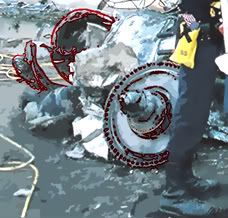 |
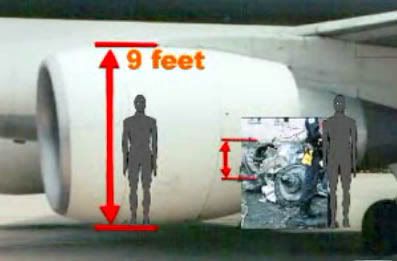 Eric Hufschmid made the same call as Desmoulins in his video Painful Deceptions, seeing the rotor and its slightly-smaller casing as proof the "engine" here is too small for a 757 and more likely the single engine of a Global Hawk.
Eric Hufschmid made the same call as Desmoulins in his video Painful Deceptions, seeing the rotor and its slightly-smaller casing as proof the "engine" here is too small for a 757 and more likely the single engine of a Global Hawk. 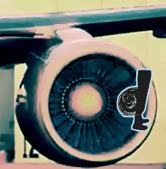 |
Speculation arose early on that the part was from a 757 but not from its engine. As Loose Change explained “after this photo was published by American Free Press readers wrote in to suggest that the turbine was a piece from the auxiliary power unit (APU) mounted in the tail section of a 757." Others like Jon Carlson have dismissed this as speculation "dropped into the conversation as disinformation.” [6] Chertoff-busting Chris Bollyn implausibly claims he contacted people at Honeywell (makers of the APU), Pratt & Whitney and Rolls-Royce, (makers of the engines used on 757s) and was able to get confirmation on all three fronts from someone employed there that the non-descript round part was definitely not from anything any of them built. [7]
Karl Schwarz was able to positively identify it as "a "turbojet" component from an US Air Force/Navy vintage type of jet engine technology that was used on just a limited number of fighters, bombers and reconnaissance planes." His prime culprit is pf course the JT8D, a tiny engine used in pairs on the tiny A3 Sky Warrior. It seems the A3 doesn't actually use JT8Ds after all, as explained in my "A3 Skywarrior Theory" post.
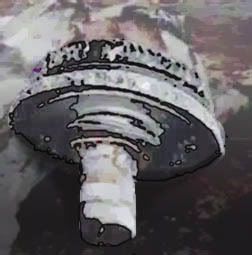 |
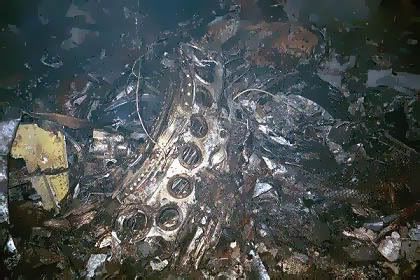 |

Finally another VATF-1 photo. A round rim (bottom right): another engine part? Source: Sarah Roberts.
[1] ERROR: 'Engine Parts From the Pentagon Crash Don't Match a 757' http://911review.com/errors/pentagon/turbofans.html
[2] COMMENTS ON MYTHOLOGY BUBBLE PART 5. http://perso.orange.fr/jpdesm/pentagon/pages-en/wr-eng.html
[3] http://911review.org/Wiki/PentagonPlaneRotor.shtml
[4] http://www.aerospaceweb.org/question/conspiracy/q0265.shtml
[5] See [1].
[6] Carlson, Jon. "Missing Pentagon Jet Engine Identified? - A 727 JT8D Rense.com. 3-2-2005. http://www.rense.com/general63/ident.htm
[7] See [6].
[8] Roberts, Sarah. “Photos Of Flt 77 Wreckage Inside The Pentagon” Exclusive Photos & Story Remse.com. 12-4-2002 http://www.rense.com/general32/phot.htm
[9] "The Five-Sided Fantasy Island: An analysis of the Pentagon crash on 9-11." version 2.0 (3/12/2004) Page 3 of 5. By Richard Stanley & Jerry Russell. 911 Strike. http://www.911-strike.com/engines.htm









No comments:
Post a Comment